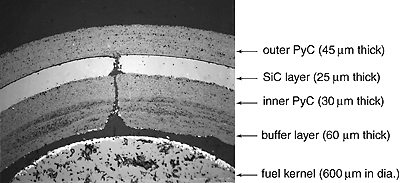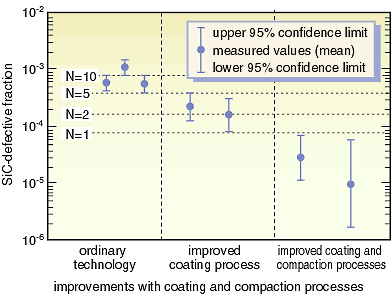In the high-temperature engineering test reactor (HTTR, a 30-MW
(thermal) high-temperature gas cooled reactor which has been constructed
by JAERI, and which went critical on November 10, 1998), about
109 coated fuel particles (about 1 mm in diameter) are loaded. It
is essential that the coated layers of these fuel particles are
sound in order to confine fission products. To ensure the safety
of the reactor and to reduce the cost of fuel manufacturing, the
improvement in quality and the decrease of the defective fraction
of fuel particles are indispensable.
Aiming at high-quality products, defective particles in about
a million manufactured fuel particles have been selected and thoroughly
examined to determine the causes of the coating failures. The
selected particles have been classified according to the morphology
of defective coated layers and studied with respect to the mechanisms
of the coating failure. The appearance of a SiC-defective layer
which is one of six typical failures, is shown in Fig. 3-5. A
study to search for the optimum conditions in both the coating
and compaction processes of the fabrication was performed. Thus,
it has been found that the defective fraction of the SiC coated
layer is decreased greatly by the following improvements; (1)
optimizing the mode of the particles fluidization, (2) developing
the process without unloading and loading the particles at intermediate
coating steps, and (3) optimizing the combinations of pressing
temperature and speed of the over-coated particles. These results
are summarized in Fig. 3-6.
The quality of Japanese coated fuel particles is greatly improved
and is nowadays superior to that of those of Germany and the United
States, countries which have taken a leading part in coated fuel
particles manufacturing. At present only Japan possesses this
technology, as both the other countries have stopped manufacturing
coated fuel particles. |

